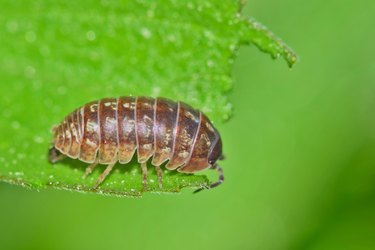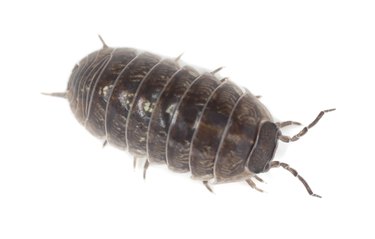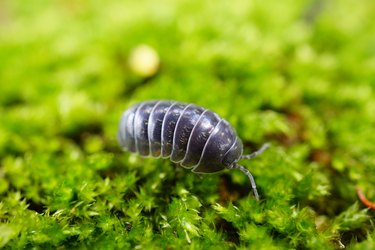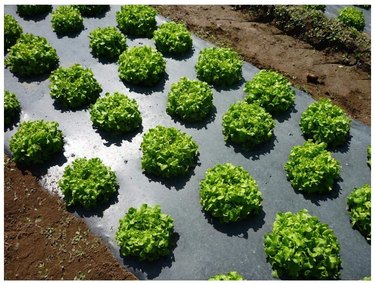Sharing its morphological characteristics with fish, armadillos and even kangaroos, a roly-poly (Armadillidium vulgare) surely wins the prize as one of the most unique backyard creatures you may encounter. It breathes through gills like a fish, raises its young in a pouch like a kangaroo and protects itself with body armor like an armadillo. As a terrestrial crustacean, the roly-poly's aquatic crustacean counterparts include lobsters and shrimp.

Video of the Day
Adding another level of intrigue to its description is one of its common names – pillbug – because a roly-poly isn't even a bug. Taxonomically, true bugs belong to the order Hemiptera, but a roly-poly belongs to the order Isopoda.
Video of the Day
Science aside, these anomalous organisms are generally elusive creatures that cause little (if any) harm to your plants because they primarily feed on decaying organic matter. However, they may also feed on living plant material, particularly the parts of plants that contact the soil, such as leaves, stems or fruit. If the roly-poly population in your garden warrants control because of the damage they're causing, controlling these otherwise innocuous creatures requires just a few tweaks to their environment.
Roly-Poly Identification and Habitat
Differentiating between pillbugs (roly-polies) and sowbugs, both of which are classified as terrestrial crustaceans, is easy because of one characteristic. Although they resemble each other at first glance, a pillbug can roll into a ball (a "pill") while a sowbug cannot. Think of an armadillo's coat of armor and then mentally flatten the look of it and drastically reduce its size to have an idea of what the top side of a roly-poly looks like. An adult roly-poly averages only 1/2 to 5/8 inch in length, and the juveniles progress through a series of molts to reach this mature size.
Unlike other crawling garden pests, you won't see roly-polies climbing all over your plants. In fact, you may never find them on your plants because they're active at night. You may see them during the day if you disturb leaf litter or mulch in your garden, and if you move some of your potted plants, you may see them hiding underneath. These nocturnal creatures seek moist places because they cannot breathe through their gills without moisture.

Roly-Poly Life Cycle
A roly-poly actually incubates 100 to 200 eggs in a brood pouch beneath her thorax. Called a marsupium, this pouch is filled with water and nutrient fluid, which facilitates breathing for the hatchlings and also feeds them. The young emerge from the eggs after about four weeks in the pouch, but they remain in the pouch for another couple of weeks before leaving the mother, which may raise up to three broods each year.
When the young leave the pouch, they go through a series of molts to shed their skin as they grow. After four or five molts, the young become adults, but they continue the molting process throughout their life. Their life span is two to five years.

Roly-Poly Plant Damage vs. Benefits
Roly-polies are scavengers, primarily eating dead and decaying matter in your yard and garden. In the language of composting, these pillbugs are primary consumers in a compost pile (earthworms are other primary consumers). As they feed on organic matter, pillbugs break it down until it decomposes, and as any organic gardener knows, this decomposed matter enriches the soil by improving the soil structure, increasing its water-holding capacity and adding nutrients.
So, the presence of a few roly-polies – or even a lot of them – can benefit your garden because of their composting contribution. However, if these beneficial decomposers are also eating your tiny seedlings, strawberries or other fruits and vegetables, the damage they cause may outweigh their composting benefits. Because they must stay moist in order to breathe through their gills, the damage they cause is typically right at the soil level. This is why tiny, succulent seedlings and strawberries (or other fruits and veggies that touch the soil) are generally the most vulnerable.
Roly-Poly Damage and Roly-Poly Control
You can remove roly-polies by picking them off your plants, but since they usually feed at night, you'll likely not get them all if you're hand-picking during daylight hours. If you scratch around the base of your plants during the day, however, you may see them congregating in the leaves and mulch. Don't worry about injury if you handle them because roly-polies do not bite or sting. You can safely pick them up, collect them in a container and relocate them away from your garden to your compost pile.
A few simple cultural controls work best to control roly-polies. If you're setting out seedlings, make a collar out of plastic, such as the top of a plastic gallon water jug or a small plastic cup with the bottom cut out, and press it into the soil around the tiny transplants. The plastic acts as a barrier to keep roly-polies away from your seedlings but just make sure that the collar doesn't form a barrier that keeps them inside. Rake away the soil and mulch before you transplant seedlings to remove any tiny roly-polies that could be trapped inside by a plastic collar.
Keep vegetables and fruits off the soil if possible, which is a challenge when growing certain edibles, such as strawberries. When it's not practical to keep low-hanging fruit and veggies off the soil or above the mulch, use black plastic mulch around your plants instead of an organic alternative. This mulch doesn't offer the moist, organic environment that attracts roly-polies.
A product approved for organic gardening that works to control roly-polies is diatomaceous earth (DE). Made of crushed and fossilized aquatic organisms called diatoms, DE works by cutting into the soft underbelly of pillbugs as they crawl across it. You may want to use DE only if the damage caused by large populations of pillbugs is significant. Otherwise, cultural controls and prevention methods are your go-to strategies.
Roly-Poly Prevention Strategies
Understanding the roly-poly's need for a moist environment to sustain its life sheds light on how to modify your garden habitat and make it inhospitable for them. Overwatering plants is not only detrimental to their health but it can also keep your garden too wet. By watering early in the day, the soil's surface has a chance to dry. If you use organic mulch, pull it away from plants instead of snugging it up too closely, a practice that's better for plant health anyway.
If you have any container plants that you overwinter inside, you may find that roly-polies climb into the drainage holes, a place that provides moisture and nourishment from the organic matter in the soil or potting mix inside. In order to prevent any hitchhikers from coming inside with your container plants, cut some landscape fabric to fit the bottom of your pots before filling them with potting mix and plants. The fabric allows water to drain but provides a barrier to keep out roly-polies.
Recommended Products Summary
- Mulches plants while repelling roly-polies
- Suppresses weeds
- Keeps fruits and vegetables from resting on the soil or organic mulch
- Organic roly-poly control
- Just sprinkle over the soil or mulch
- No adverse effects on the environment when used properly
- Allows containers to drain while blocking roly-polies' entry through drainage holes
- Can be easily custom cut to fit different container sizes and shapes


